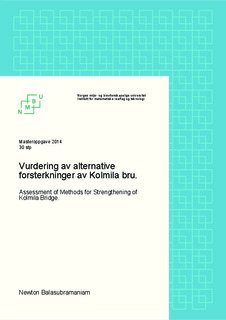| dc.description.abstract | I Norge har vi mange skogsbilveger, og mange av disse har bruer som ble bygget på 1950- og 60-tallet. På den tiden var det helt andre laster ved dimensjonering av bruer enn hva vi har i dag. I forbindelse med uttak av skog er det ofte nødvendig å kontrollere om bruene har tilstrekkelig bæreevne. Kolmila bru i Hattfjelldal kommune har to spenn, ett over elva på 26 meter og ett over land på 8 meter. Den er èn av mange eldre stålbjelkebruer med tredekke på skogsbilvegene som må forsterkes for å tilfredsstille krav som stilles for tunge vogntog.
I 2012 ble det utført en såkalt spesialinspeksjon av brua, hvor tilstanden for bæresystemet og øvrige elementer ble registrert, og forslag til utbedring ble utarbeidet. I inspeksjonsrapporten antas brua å være underdimensjonert for Bk10, den høyeste bruksklassen som gjenspeiler brukslasten som tillates å trafikkere brua.
Bæreevnen til brua måtte bestemmes, men da selve grunnlaget for dokumentasjonen til brua i form av prosjekteringsarbeid og byggetegninger mangler, ble det i første omgang med god hjelp av inspeksjonsrapporten og skogkonsulenter i Hattfjelldal utarbeidet nødvendig grunnlagsmateriale, som byggetegninger og beskrivelse av utbedringstiltak.
Etter en gjennomregning av hovedbæresystemet, ble bruas bæreevne klassifisert til Bk6, den laveste bruksklassen. Mange ulike forsterkningsmetoder er omtalt, og blant disse fremstår følgende som mest aktuelle:
• Alternativ A – Legge inn ekstra bjelker
• Alternativ B – Forsterkning av bærebjelker ved hjelp av stålplater eller kanalprofiler
• Alternativ C – Anvendelse av strekkstagsystem
Alternativene er prosjektert og byggekostnadene for hvert av dem er estimert.
Konklusjonen, etter analysen og drøftingen av resultatene, er at den beste forsterkningsmetoden for Kolmila bru er å legge inn ekstra bjelker for det korteste bruspennet, og anvende strekkstagsystem for det lengste bruspennet. En kostnadsvurdering viser at det er tre ganger så dyrt å bygge en ny bru fremfor å rehabilitere den gamle brua. Forskjellen er så stor at selv om vedlikeholdskostnadene er lavere og levetiden er lengre, vil livssykluskostnaden over et 100-års perspektiv bli større for ei ny bru enn for en rehabilitert bru som krever noe mer vedlikehold i løpet av samme periode. Dermed er det ikke gunstig å totalutskifte Kolmila bru.
Norway is home to many forest roads and many bridges were constructed on these roads in the 1950s and 60s. There has been a complete change in the type of vehicles that travel on these bridges and this means that the loads applied on the bridges in those times are different from those of todays, hence the bridges must be examined to estimate if they are strong enough to withstand today's load. One such bridge is the Kolmila Bridge in Hattfjelldal municipality. The bridge has two spans; one above the river at 26 meters and the other above the land at 8 meters. It is one of many older steel beam bridges with timber decks on forest road that needs to be enhanced to meet the requirements imposed by heavy trucks.
In 2012, a special inspection of the bridge was performed. The condition of the load bearing structure and other elements were found to be deficient according to current requirements. The findings of the study established that the bridge had design limitations for user class 10, the highest user class that reflects the user load permitted on the bridge.
The load bearing capacity of the bridge had to be determined for this project, but key aspects that form the very basis of the documentation, of engineering and design drawings were unavailable. However, relying on the inspection report and forestry consultants in Hattfjelldal for initial background material, structure design plans were drawn and several recommendations were formulated as remedial measures to rectify the design limitations.
An analysis of the main load bearing structure revealed that the bridge's load bearing capacity conformed to user class 6, the lowest possible rating. Many different strengthening methods are discussed, among which the following stand out as the most common:
• Option A - Adding extra beams
• Option B - Reinforcement of beams using steel plates or U channels
• Option C - Application of tension rod system
The structural design of the alternatives listed above was evaluated. Additionally, the cost of each option was estimated.
The conclusion, after analysis and discussion of the results, is that the best strengthening method for Kolmila Bridge is to add extra beams for the shortest bridge span, and apply tension rod system to the longest bridge span. Considering design and cost-benefit analysis it was deduced that it would cost three times as much to design an entirely new bridge as opposed to rehabilitating the existing bridge. The difference is so great that even though maintenance costs are lower and the design life is longer for a new bridge compared to the rehabilitated of the old bridge, the life cycle cost (LCC) from a 100 - year perspective will be larger for the new bridge than for the rehabilitated bridge and therefore, it is not recommended that Kolmila Bridge be entirely replaced. | nb_NO |

